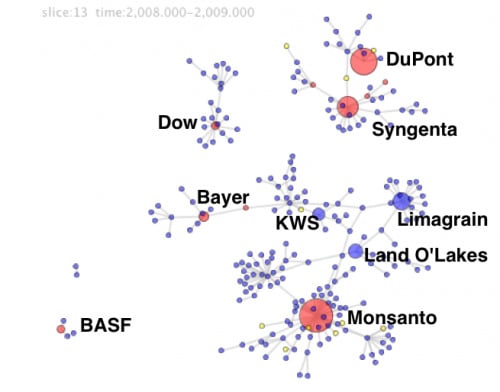Visualizing Consolidation in the Global Seed Industry: 1996–2008
Abstract
:1. Introduction
2. Theoretical Perspectives
2.1. Barriers to Accumulation
2.2. Agricultural Treadmillls
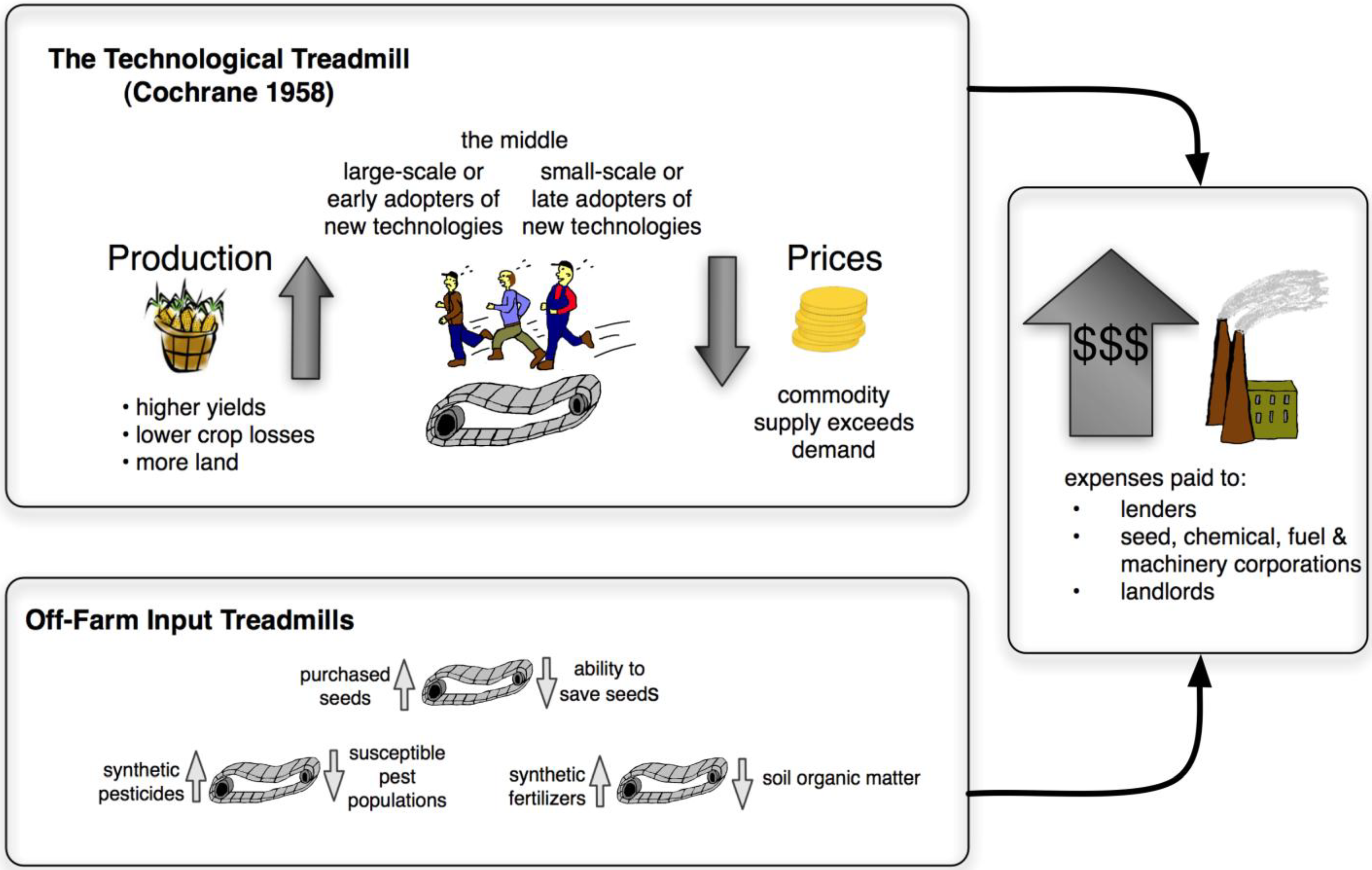
2.3. Consolidation
3. Methods
3.1. Approach
3.2. Time Period
3.3. Data Sources
3.4. Data Analysis and Display
4. Results and Discussion
4.1. Overview
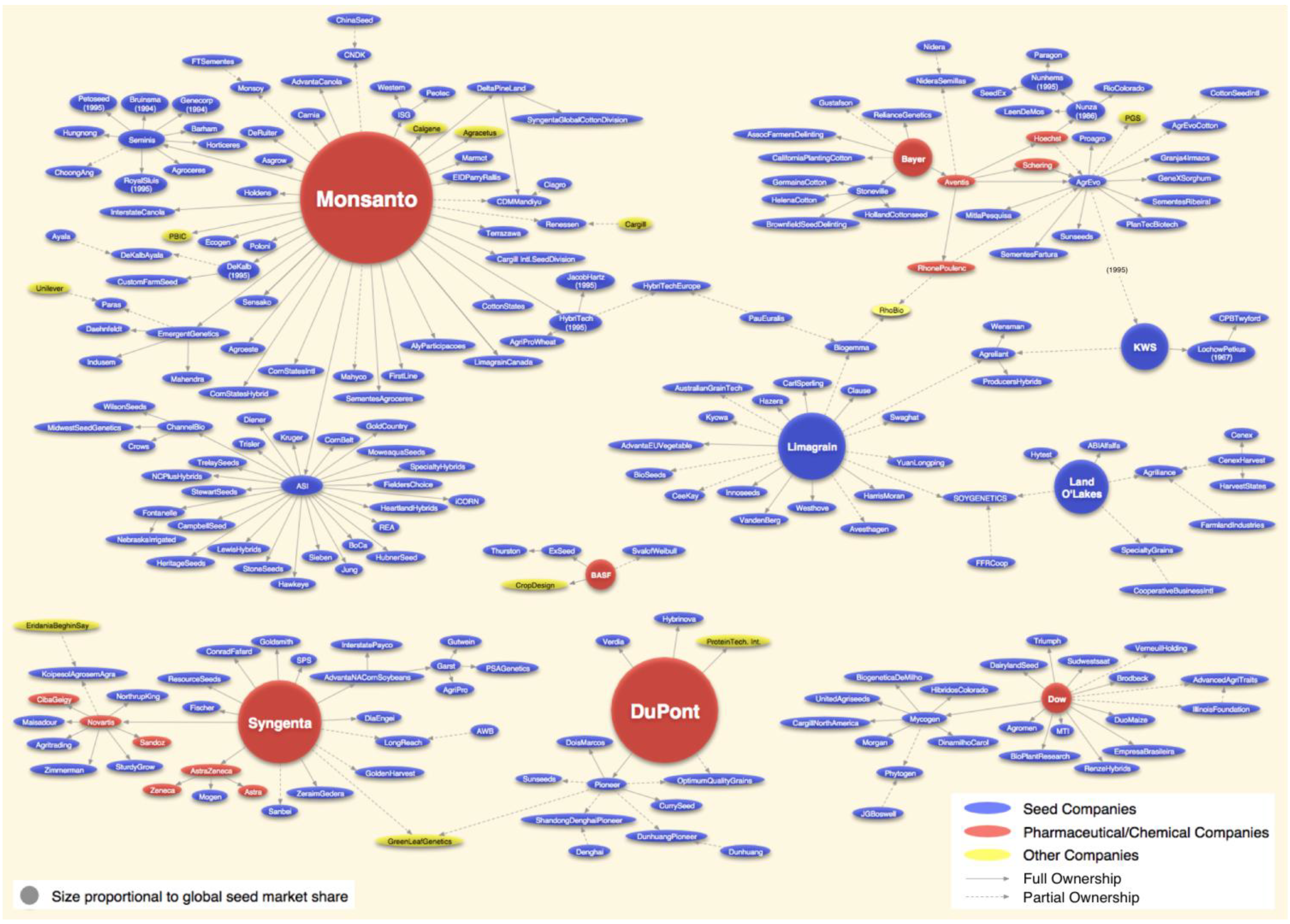
4.2. The Big Six ‘Life Science’ Corporations
4.2.1. Monsanto
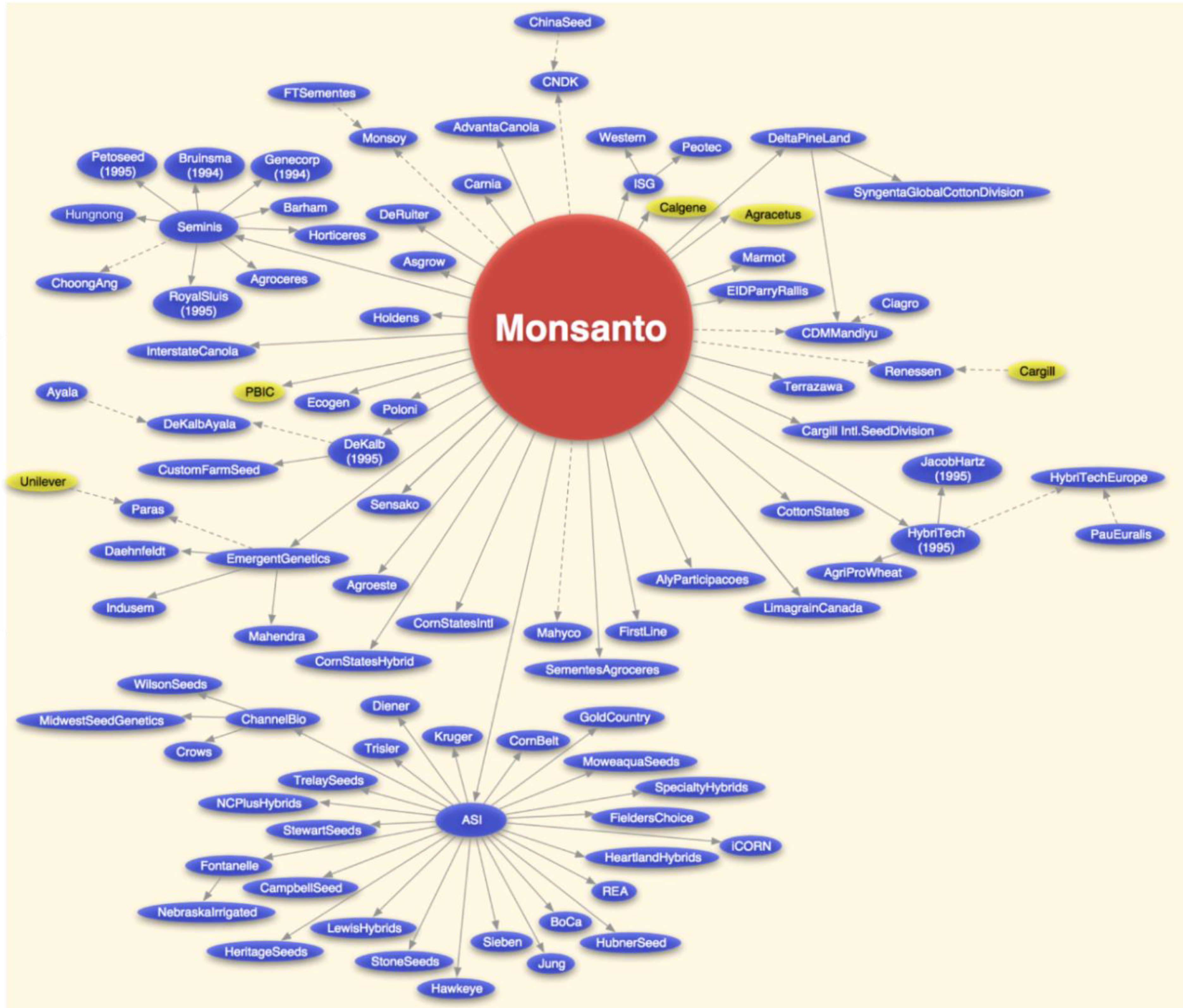
4.2.2. DuPont
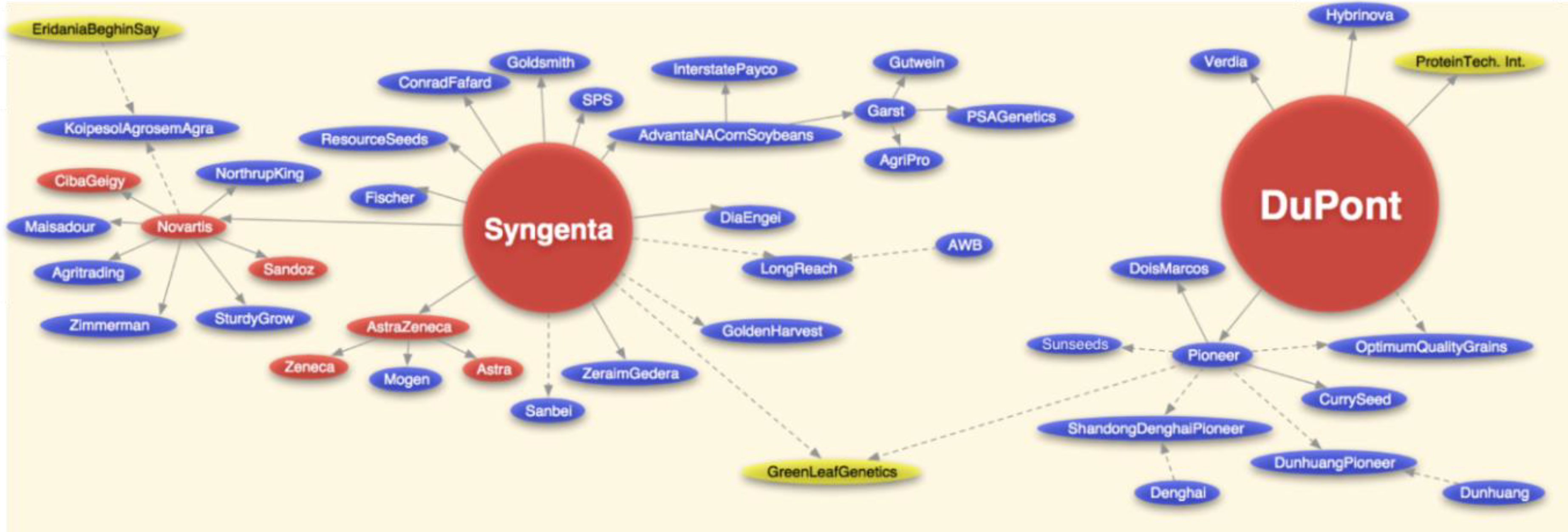
4.2.3. Syngenta
4.2.4. Bayer
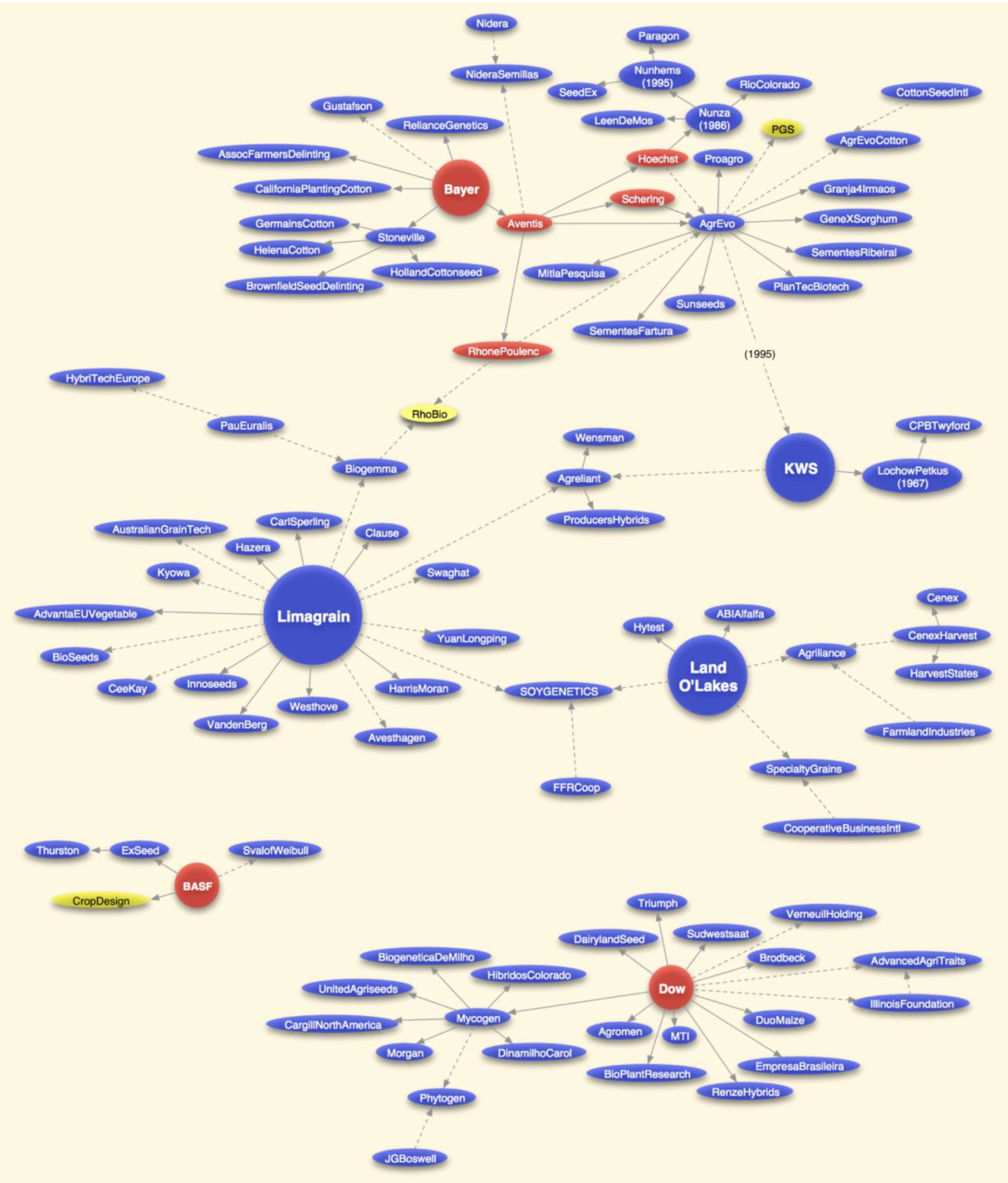
4.2.5. Dow
4.2.6. BASF
4.2.7. Cross-licensing
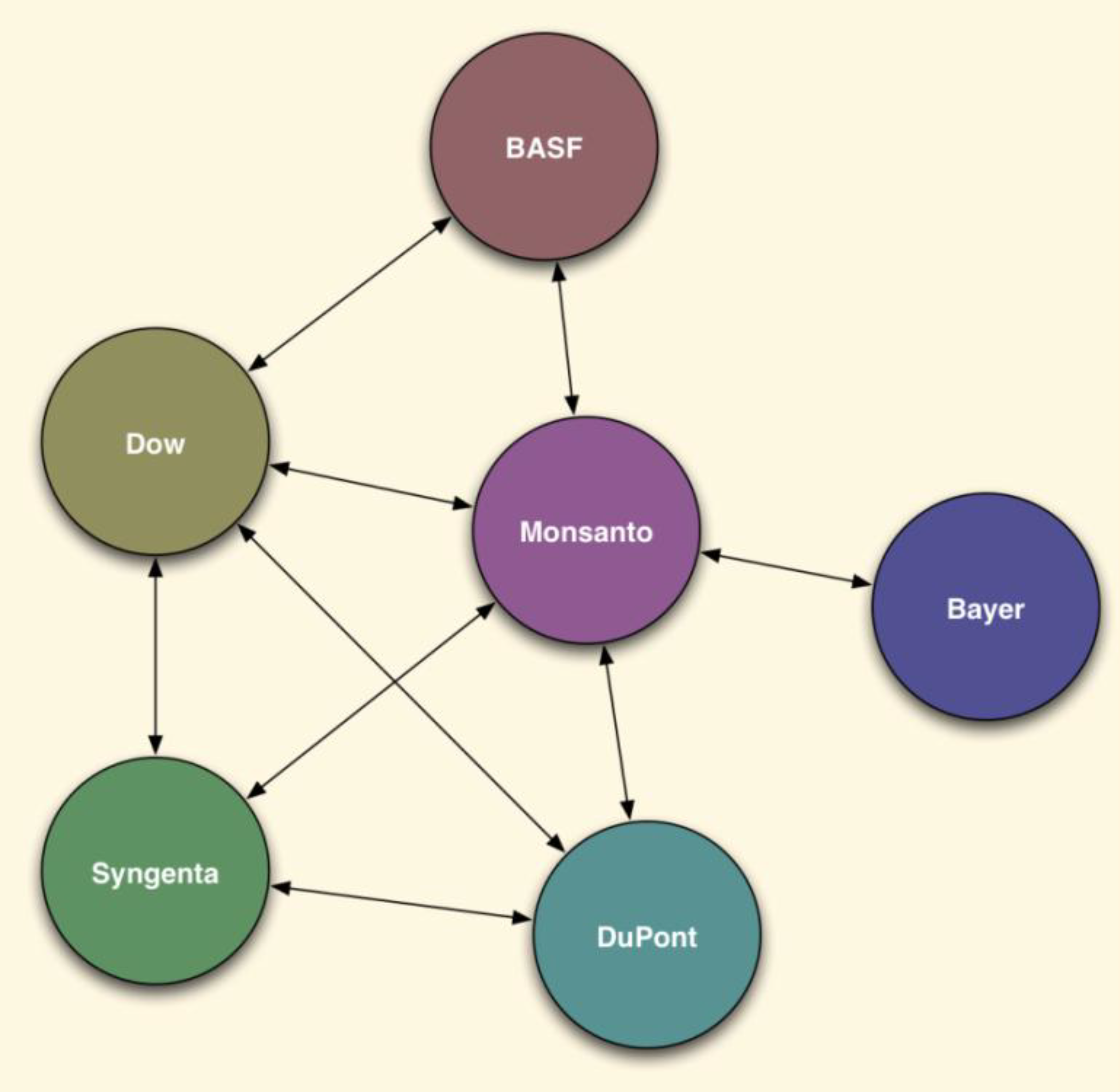
4.3. Cooperatively-Owned Global Seed Companies
4.3.1. Land O’Lakes
4.3.2. Limagrain
4.4. Future Trends?
4.5. Implications for Renewable Agriculture
5. Conclusions
Acknowledgements
Supplement 1. Animation of Consolidation in the Global Seed Industry
References and Notes
- Fernandez-Cornejo, J.; Just, R.E. Researchability of modern agricultural input markets and growing concentration. Am. J. Agric. Econ. 2007, 89, 1269–1275. [Google Scholar] [CrossRef]
- Mascarenhas, M.; Busch, L. Seeds of change: intellectual property rights, genetically modified soybeans and seed saving in the United States. Sociol. Ruralis. 2006, 46, 122–138. [Google Scholar] [CrossRef]
- Kloppenburg, J.R. First the Seed: The Political Economy of Plant Biotechnology, 2nd ed.; University of Wisconsin Press: Madison, WI, USA, 2005. [Google Scholar]
- Volkening, T. Seed savers exchange. J. Agric. Food Inf. 2006, 7, 3–15. [Google Scholar] [CrossRef]
- Hayenga, M. Structural change in the biotech seed and chemical industrial complex. AgBioForum. 1998, 1, 43–55. [Google Scholar]
- Harl, N.E. The age of contract agriculture: consequences of concentration in input supply. J. Agrib. 2000, 18, 115–128. [Google Scholar]
- Fulton, M.; Giannakas, K. Agricultural biotechnology and industry structure. AgBioForum 2002, 4, 137–151. [Google Scholar]
- Oehmke, J.F.; Wolf, C.A. Measuring concentration in the biotechnology R&D industry: adjusting for interfirm transfer of genetic materials. AgBioForum 2003, 6, 134–140. [Google Scholar]
- Srinivasan, C.S. Concentration in ownership of plant variety rights: some implications for developing countries. Food Policy 2003, 28, 519–546. [Google Scholar] [CrossRef]
- Fernandez-Cornejo, J. The Seed Industry in U.S. Agriculture: An Exploration of Data and Information on Crop Seed Markets, Regulation, Industry Structure, and Research and Development; US Department of Agriculture, Economic Research Service, Agriculture Information Bulletin 786: Washington, DC, USA, 2004. [Google Scholar]
- Schimmelpfennig, D.; Pray, C.E.; Brennan, M. The impact of seed industry concentration on innovation: a study of U.S. biotech market leaders. Agric. Econ. 2004, 30, 157–167. [Google Scholar] [CrossRef]
- Pray, C.; Oehmke, J.; Naseem, A. Innovation and dynamic efficiency in plant biotechnology: an introduction to the researchable issues. AgBioForum 2005, 8, 52–63. [Google Scholar]
- Moretti, I.M. Tracking the Trend Towards Market Concentration: The Case of the Agricultural Input Industry; United Nations Conference on Trade and Development: Geneva, Switzerland, 2006. [Google Scholar]
- Who Owns Nature? Corporate Power and the Final Frontier in the Commodification of Life; ETC Group: Ottawa, CA, USA, 2008.
- Ware, C. Information Visualization: Perception for Design, 2nd Ed. ed; Morgan Kaufmann: San Francisco, CA, USA, 2004. [Google Scholar]
- Howard, P.H. Visualizing food system concentration and consolidation. Southern Rural Sociology 2009, 24, 87–110. [Google Scholar]
- Kautsky, K. The Agrarian Question; Zwan: Winchester, MA, USA, 1988; Vol. 1-2. [Google Scholar]
- Mann, S.A.; Dickinson, J.M. Obstacles to the development of a capitalist agriculture. J. Peasant Stud. 1978, 5, 466–481. [Google Scholar] [CrossRef]
- Goodman, D.; Sorj, B.; Wilkinson, J. From Farming to Biotechnology: A Theory of Agro-Industrial Development; Basil Blackwell: New York, NY, USA, 1987. [Google Scholar]
- Heilbroner, R.L. The Nature and Logic of Capitalism; W.W. Norton & Co.: New York, NY, USA, 1985. [Google Scholar]
- Lewontin, R.C.; Berlan, J.P. Technology, research and the penetration of capital: the case of U.S. agriculture. Mon. Rev. 1986, 38, 21–34. [Google Scholar] [CrossRef]
- Berlan, J.P.; Lewontin, R.C. The political economy of hybrid corn. Mon. Rev. 1986, 38, 35–47. [Google Scholar] [CrossRef]
- Shinkle, P. Farmer who lied in dispute with Monsanto will go to prison. St. Louis Post-Dispatch 2003, B1. [Google Scholar]
- Shand, H. New enclosures: why civil society and governments need to look beyond life patenting. Centennial Rev. 2003, 3, 187–204. [Google Scholar] [CrossRef]
- Eaton, D.; Louwaars, N. Intellectual Property Rights in the International Seed Sector and Options for Resource-Poor Farmers; Report 09-019; LEI, Wageningen UR: Hague, The Netherlands, 2009. [Google Scholar]
- Cochrane, W.W. Farm Prices: Myth and Reality; University of Minnesota Press: Minneapolis, MN, USA, 1958. [Google Scholar]
- Cochrane, W.W. The Development of American Agriculture: A Historical Analysis; University of Minnesota Press: Minneapolis, MN, USA, 1993. [Google Scholar]
- Schurman, R.; Munro, W. Targeting capital: a cultural economy approach to understanding the efficacy of two anti-genetic engineering movements. Am. J. Sociol. 2009, 115, 155–202. [Google Scholar] [CrossRef] [PubMed]
- Murray, D.L. Cultivating Crisis: The Human Cost of Pesticides in Latin America; University of Texas Press: Austin, TX, USA, 1994. [Google Scholar]
- Clark, B.; York, R. Rifts and shifts: getting to the root of environmental crises. Mon. Rev. 2008, 60, 13–24. [Google Scholar] [CrossRef]
- Drinkwater, L.; Snapp, S. Understanding and managing the rhizosphere in agroecosystems. In The Rhizosphere: An Ecological Perspective; Cardon, Z.G., Whitbeck, J.L., Eds.; Elsevier: Burlington, MA, USA, 2007. [Google Scholar]
- Jussaume, R.A.; Glenna, L. Considering structural, individual and social network explanations for ecologically sustainable agriculture: an example drawn from Washington State wheat growers. Sustainability 2009, 1, 120–132. [Google Scholar] [CrossRef]
- Weis, T. The Global Food Economy: The Battle for the Future of Farming; Zed Books: New York, NY, USA, 2007. [Google Scholar]
- Hannaford, S.G. Market Domination! The Impact of Industry Consolidation on Competition, Innovation, and Consumer Choice; Praeger: Westport, CT, USA, 2007. [Google Scholar]
- Heffernan, W.; Hendrickson, M.; Gronski, R. Consolidation in the Food and Agriculture System; National Farmers Union: Washington, DC, USA, 1999. [Google Scholar]
- Lieber, J.B. Rats in the Grain: The Dirty Tricks of Supermarket to the World, Archer Daniels Midland; Basic Books: New York, NY, USA, 2000. [Google Scholar]
- Karier, T.M. Beyond Competition: The Economics of Mergers and Monopoly Power; M.E. Sharpe: Armonk, NY, USA, 1993. [Google Scholar]
- Gordon, M.J. Monopoly power in the United States manufacturing sector, 1899 to 1994. J Post Keynesian Econ. 1998, 20, 323–335. [Google Scholar]
- Consolidation could also be viewed as a treadmill from the perspective of firms within an industry. Publicly traded corporations are legally required to generate maximal returns for shareholders. If their competitors are engaging in mergers and acquisitions that result in increased political and economic power, which in turn translates to increased profits, firms may have little choice but to follow suit. Hendrickson, M.; Wilkinson, J.; Heffernan, W.; Gronski, R. (Eds.) In The Global Food System and Nodes of Power; Oxfam America: Boston, MA, USA, 2008.
- Sieker, B. Focus: Seed; The Context Network: West Des Moines, IA, USA, 2009. [Google Scholar]
- Morris, M.; Singh, R.; Pal, S. India's maize seed industry in transition: changing roles for the public and private sectors. Food Policy 1998, 23, 55–71. [Google Scholar] [CrossRef]
- Lesser, W. Intellectual property rights and concentration in agricultural biotechnology. AgBioForum. 1999, 1, 56–61. [Google Scholar]
- Glenna, L.; Cahoy, D.R. Agribusiness concentration, intellectual property, and the prospects for rural economic benefits from the emerging biofuel economy. Southern Rural Sociology 2009, 24, 111–129. [Google Scholar]
- Paul, H.; Steinbrecher, R.; Michaels, L.; Kuyek, D. Hungry Corporations: Transnational Biotech Companies Colonise the Food Chain; Zed Books: London, UK, 2004. [Google Scholar]
- Tidwell, J. Designing Interfaces: Patterns for Effective Interaction Design; O'Reilly Media: Sebastopol, CA, USA, 2005. [Google Scholar]
- Card, S.K.; Mackinlay, J.D.; Shneiderman, B. Readings in Information Visualization: Using Vision to Think; Morgan Kaufmann: San Francisco, CA, USA, 1999. [Google Scholar]
- Pioneer Hi-Bred International. In Seed Industry Structure; Pioneer Competitive Intelligence Group, Marketing Department: Johnston, IA, USA, 2000.
- SeedQuest. http://www.seedquest.com (accessed 14 September 2009).
- Moore, M. What's up with seed? Farm Industry News. 15 February 2009. Available online: http://farmindustrynews.com/seed/0215-highpriced-acreage-driving-costs/ (accessed on 16 July 2009).
- McFarland, D.; Bender-deMoll, S. Sonia V1.2.0 (Social Network Image Animator); Stanford University: Palo Alto, CA, USA, 2007. [Google Scholar]
- Batagelj, V.; Mrvar, A. Analysis and visualization of large networks. In Graph Drawing Software; Jünger, M., Mutzel, P., Eds.; Springer: Berlin, Germany, 2003. [Google Scholar]
- Kamada, T.; Kawai, S. An algorithm for drawing general undirected graphs. Inf. Process. Lett. 1989, 31, 7–15. [Google Scholar] [CrossRef]
- Moody, J.; McFarland, D.; Bender-DeMoll, S. Dynamic network visualization. Am. J. Sociol. 2005, 110, 1206–1241. [Google Scholar] [CrossRef]
- Omnigraffle 5.2; The Omni Group: Seattle, WA, USA, 2009.
- Graphviz 1.0. 2005. Available online: http://www.graphviz.org (accessed on 9 March 2009).
- Horstmeier, G. Strategic bedfellows. Farm Journal 1996. [Google Scholar]
- Orelli, B. Monsanto plowed down. The Motley Fool. 11 September 2009. Available online: http://www.fool.com/investing/value/2009/09/11/monsanto-plowed-down.aspx (accessed on 16 September 2009).
- Dillon, M. Another big horticultural seed company bought by Monsanto. Grist. 4 April 2008. Available online: http://www.grist.org/article/who-owns-your-tomato (accessed 23 March 2009).
- Tomich, J. Seeds grow Monsanto's business. St. Louis Post-Dispatch 2009, A1. [Google Scholar]
- Monsanto vs. U.S. Farmers; Center for Food Safety: Washington, DC, USA, 2005.
- Is Monsanto going to develop or sell 'Terminator' seeds? Monsanto. 16 July 2009. Available online: http://www.monsanto.com/monsanto_today/for_the_record/monsanto_terminator_seeds.asp (accessed on 11 August 2009).
- Dal Bó, E. Regulatory capture: a review. Oxford Rev. Econ. Pol. 2006, 22, 203–225. [Google Scholar] [CrossRef]
- Dyer, G. Frankenstein foods. The Globe and Mail 1999, D1. [Google Scholar]
- Dupont's new corn seed distribution strategy: will it enable meaningful market share recovery? Reuters 2008.
- Tomich, J. Behind group's anti-Monsanto campaign? Dupont. St. Louis Post-Dispatch 2009, A1. [Google Scholar]
- DuPont Unveils New Strategy To Expand Its Seed Business. DuPont: Wilmington, DE, USA, 2008. Available online: http://www2.dupont.com/Production_Agriculture/en_US/news_events/cp_releases/2008-12-11.html (accessed on 2 May 2009).
- Blake, A. Syngenta ties seed sales to spray. Farmers Weekly 2003. [Google Scholar]
- Freedom to farm—or freedom to follow suppliers' orders? Farmers Weekly 2003.
- Watts, M.J. Life under contract: contract farming, agrarian restructuring, and flexible accumulation. In Living under Contract: Contract Farming and Agrarian Transformation in Sub-Saharan Africa; Little, P.D., Watts, M.J., Eds.; The University of Wisconsin Press: Madison, WI, USA, 1994. [Google Scholar]
- Fatka, J. Dow increasing seed market share. Feedstuffs 2007, 6. [Google Scholar]
- Shand, H. Corporations grab climate genes. Foreign Policy in Focus. 13 May 2008. Available online: http://www.fpif.org/fpiftxt/5223 (accessed 10 July 2009).
- Monsanto Transgenic Trait Dominance in U.S. Market 1996–2007; Organization for Competitive Markets: Lincoln, NE, USA, 2008.
- Barboza, D. Questions seen on seed prices set in the 90's. The New York Times 2004, A1. [Google Scholar]
- Olson, J. Accessing seed technologies: will your local seed supplier have the seeds you want? Farm Industry News. 1 December 1998. Available online: http://farmindustrynews.com/mag/farming_accessing_seed_technologies/ (accessed 7 August 2009).
- Boland, M.; Amanor-Boadu, V.; Barton, D. Land O'Lakes. Int. Food Agrib. Manage. Rev. 2004, 7, 63–75. [Google Scholar]
- Overwater, T. Giant views of the industry. Germination. February 2009. Available online: http://www.seedquest.com/hosting/germination/giantviews/o/OverwaterTony/default.htm (accessed 25 June 2009).
- USDA and Justice Department to Hold Public Workshops To Explore Competition Issues In The Agriculture Industry; USDA Release No. 0368.09; USDA: Washington, DC, USA, 2009.
- Then, C.; Tippe, R. The Future of Seeds and Food Under the Growing Threat of Patents and Market Concentration; No Patents on Seeds Coalition: Hamburg, Germany, 2009. [Google Scholar]
- Dillon, M. 'And We Have the Seeds:' Monsanto Purchases World's Largest Vegetable Seed Company; Organic Seed Alliance: Port Townsend, WA, USA, 2005. [Google Scholar]
- Gepts, P.; Hancock, J. The future of plant breeding. Crop Sci. 2006, 46, 1630–1634. [Google Scholar] [CrossRef]
© 2009 by the authors; licensee Molecular Diversity Preservation International, Basel, Switzerland. This article is an open access article distributed under the terms and conditions of the Creative Commons Attribution license (http://creativecommons.org/licenses/by/3.0/).
Share and Cite
Howard, P.H. Visualizing Consolidation in the Global Seed Industry: 1996–2008. Sustainability 2009, 1, 1266-1287. https://doi.org/10.3390/su1041266
Howard PH. Visualizing Consolidation in the Global Seed Industry: 1996–2008. Sustainability. 2009; 1(4):1266-1287. https://doi.org/10.3390/su1041266
Chicago/Turabian StyleHoward, Philip H. 2009. "Visualizing Consolidation in the Global Seed Industry: 1996–2008" Sustainability 1, no. 4: 1266-1287. https://doi.org/10.3390/su1041266
APA StyleHoward, P. H. (2009). Visualizing Consolidation in the Global Seed Industry: 1996–2008. Sustainability, 1(4), 1266-1287. https://doi.org/10.3390/su1041266




